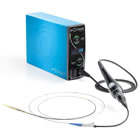|
The study was published simultaneously in the Journal of the American College of Cardiology. Granted "Breakthrough Device Designation" by the FDA, the IVL catheter is an innovative therapy designed to fracture problematic calcium using sonic pressure waves in order to facilitate stent delivery, deployment and optimal expansion. Severely calcified coronary lesions present a major challenge in opening up the coronary arteries using stents. If a stent is restrained from fully expanding by a hard calcium shell, it will likely be malapposed, possibly deformed, or the polymer damaged by the hard calcified edge. All of these conditions are major risk factors for stent thrombosis, restenosis, and vessel failure. Various modalities have been used over the years to crack or reduce the calcium, from orbital and rotational atherectomy to cutting and scoring devices and high-pressure balloons. But each one of these devices has drawbacks, such as vessel trauma, arterial dissection, and the need for extensive training of practitioners. Enter the Shockwave IVL System. Based on the technology that has been used in breaking up kidney stones, balloon catheters were designed to emit sonic pulses to fracture hard calcified areas in the peripheral vessels and then adapted to the coronary vasculature. The results, as shown in the DISRUPT CAD III Study, were excellent: a high degree of safety and efficacy and, importantly, simple to use, needing minimal training. 431 patients were enrolled at 47 global sites in the United States, France, Germany, and the United Kingdom. 47 of these patients were "roll-ins," one per investigational site so that the operators could have an introductory case to become familiar with the system. These roll-ins were excluded from the primary analysis, so the total number of patients analyzed was 384. The primary safety endpoint of 30-day freedom from MACE was 92.2%. The primary effectiveness endpoint of procedural success was 92.4%. Both safety and efficacy met, and exceeded, the comparison Performance Goal that had been determined, based on the results of the 2014 ORBIT II study of orbital atherectomy. Interestingly, the lesions treated in DISRUPT CAD III were significantly more complex than those in ORBIT II: the mean calcified segment length was 47.9mm vs. 28.6mm. The mean calcium angle was 292.5° and calcium thickness was 0.96mm at the site of maximum calcification. These were highly calcified lesions, representing "the most severe target lesion calcification treated in any IDE study of calcium modification technology to date." OCT was performed in 100 of the patients and demonstrated multi-plane and longitudinal calcium fractures after IVL in 67.4% of lesions. Minimum stent area was 6.5mm2 and was similar regardless of demonstrable fractures on OCT. Another major difference from atherectomy devices was in the learning curve: while orbital and rotational atherectomy devices can be complicated to set up and require a not-insignificant amount of training in order to be used safely and effectively, the learning curve for IVL is virtually non-existent. When the results of the total cases were compared to those for the "roll-ins" (the very first procedures done by each investigator) there were no differences in outcomes. However, IVL does not replace atherectomy, but rather partners with it. For example, these highly calcific plaques sometimes keep the IVL balloon from crossing the lesion, so a rotational atherectomy burr can be used to drill a kind of pilot hole, a technique practitioners call "roto-tripsy." And sometimes the calcium jacket is just too thick and needs to be debulked, using these more complex devices. The co-principal investigators of the study are Dean Kereiakes, MD, FACC, FSCAI, Medical Director of The Christ Hospital Heart and Vascular Center and the Christ Hospital Research Institute, Professor of Clinical Medicine, The Ohio State University, and Jonathan Hill, MD, Consultant Cardiologist at Royal Brompton Hospital in London. Dr. Kereiakes discussed with Angioplasty.Org the increasing importance of treating calcification, both in the coronaries and the peripheral vessels (that are used for access):
"There's never been a time in our history when vascular calcification is a bigger problem than it is now. Because aging population, prevalence of diabetes, prevalence of chronic kidney disease, if you look at GFRs (Glomerular Filtration Rate) under 60, because of the age...I mean these things all lead to calcification. "[And] there's never been a time in our history that large bore catheter access is more important than it is now. The miniaturization of technologies, EVAR, TAVR, mechanical cardiac support, Impella -- and what is the primary access? Transfemoral. Where does everybody wanna go? Transfemoral. Up to 50% of people in that age group who need this procedure have got moderate to severe calcium of the femorals or iliac arteries. So it's kind of a perfect storm. Vascular calcium has never been a bigger problem than it is now, large bore catheter access has never been more important than it is now." (Look for our full interview with Dr. Kereiakes, which will be posted soon.) IntraVascular Lithotripsy (IVL) is one of the more recent innovations that has found its way into the armamentarium of the interventional cardiologist. It's being used in Europe; based on the results of the DISRUPT CAD III Study, it may soon become available in the U.S. Reported by Burt Cohen, Angioplasty.Org, October 15, 2020 |


